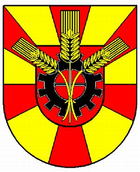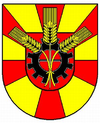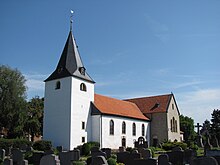Rang out
| coat of arms | Germany map | |
|---|---|---|

|
Coordinates: 52 ° 11 ′ N , 10 ° 6 ′ E |
|
| Basic data | ||
| State : | Lower Saxony | |
| County : | Hildesheim | |
| Height : | 89 m above sea level NHN | |
| Area : | 80.03 km 2 | |
| Residents: | 7901 (Dec. 31, 2019) | |
| Population density : | 99 inhabitants per km 2 | |
| Postal code : | 31174 | |
| Area code : | 05123 | |
| License plate : | HI, ALF | |
| Community key : | 03 2 54 029 | |
| LOCODE : | DE 74P | |
| Community structure: | 12 localities | |
| Address of the municipal administration: |
Rathausstrasse 8 31174 Schellerten |
|
| Website : | ||
| Mayor : | Axel Witte ( CDU ) | |
| Location of the community Schellerten in the Hildesheim district | ||
Schellerten is a municipality in the east of the Hildesheim district in Lower Saxony (Germany). It is characterized by agriculture.
Geographical location
The community of Schellerten is located in the Hildesheimer Börde or, strictly speaking, already just under the Ilseder Börde , cf. Braunschweig-Hildesheimer Lößbörde , on the southern edge of the North German Plain . A few kilometers south of the core town lies the Vorholz ridge , which introduces the Innerstebergland and thus also the low mountain range threshold. In the north of the village of Schellerten, the rivers Dingelber Klunkau and Dinklarer Klunkau create the Bruchgraben .
history
The community was established on March 1, 1974 from the following twelve localities, which still make up the community of Schellerten today:
|
|
Schellerten locality
The area around Schellerten was already settled in prehistoric times. This is proven by Iron Age settlement remains and artefacts that were discovered in 2018 during archaeological investigations in a new development area on the western edge of the municipality.
Schellerten is first mentioned by name in 1244. In this oldest dated documentary mention, the Hildesheim Bishop Konrad transfers three Hufen Land in Schelerthe to the Hildesheimer Kreuzstift .
Schellerten, located in the so-called Little Abbey of the Prince Diocese of Hildesheim , became Evangelical Lutheran in 1556. Despite massive attempts at recatholization under Prince-Bishop Ernst von Bayern (1573-1612), the re-establishment of the Catholic religion in Schellerten was no longer successful. The Schellert pastor Ulrich Gerlandt and Duke Heinrich Julius von Braunschweig, to whom the Schellert citizens transferred the patronage rights to their church in 1604, played a decisive role. In violation of imperial law ( Augsburg religious peace , Cuius regio, eius religio ), the duke ensured that Schellerten remained Lutheran in 1610 by force of arms.
In 1603, at the time of Pastor Gerlandt, the Schellert church tower collapsed. It was not rebuilt until 1615. The nave of the Evangelical Lutheran Church, built in 1766. Church is equipped with a pulpit altar and organ prospect in Rococo style as well as three ceiling frescoes by the Hildesheim baroque painter Joseph Gregor Winck . They show the birth, death and resurrection of Christ.
Between 1850 and 1861, the special division of meanness and coupling of the field mark of Schellerten took place in connection with the abolition of field and meadow protection . From the farming community, which had previously been dependent on various landlords, a community emerged with independent farmers who own their lands.
In 1873 the Ahstedt-Schellerter Zuckerfabrik AG started operations. Until 1964, she independently produced sugar from the beet in the region. Then it merged with the sugar factory in Rethen (Leine) . Operations initially continued in both plants. In 1967 the Ahstedt-Schellerter sugar factory ceased operations. The old sugar factory site served as a loading station for sugar beets for around 15 more years, which are now processed in Rethen.
Since 1974, the village Schellerten seat of the same name, consisting of twelve places unified community .
In 1986 the construction of a potato warehouse changed the local agriculture. While sugar beets and wheat had become the main crops since the last third of the 19th century, more and more potatoes were grown in the region.
Since 2006, for the first time in its history, Schellerten has been growing towards the west through residential development.
Local coat of arms
The local council of the village of Schellerten chose a coat of arms for Schellerten in the 1950s. It shows a stepped gable taken from the coat of arms of the Harlessem family. The Hildesheim patrician family was enfeoffed with lands in Schellerten for the first time in 1439. Based on the Schellert church seal, which shows a key, the gable field has two crossed keys. The colors red and gold indicate that Schellerten once belonged to the heartland of the Hildesheim bishopric , whose colors are the above.
Dinklar village
Dinklar is named under the name Dinkelere as the court of the Saxon Duke Heinrich and the place of his king's election in 919, making it one of the places in Lower Saxony that was attested early on. The name could refer to a thing site or to the cultivation of spelled or wheat.
Kemme locality
Kemme was first mentioned in 1025 as an estate with the name Kemnium , which Bishop Sigebert von Minden received as a gift from King Konrad II . Protestant teaching was introduced in Kemme in 1557, but it wasn't until 1653 that the place finally became Protestant. In 1810 there were 316 inhabitants in 47 houses in Kemme. In 1965, Kemme won first prize in the competition “Our village should become more beautiful”. In 1974 it was incorporated into Schellerten. On June 30, 2009, Kemme had 476 inhabitants.
Wendhausen village
Wendhausen was first mentioned in a document in 1206 as "Winethusen" and in the course of its history it was often plundered and destroyed, as it was on Heerstraße Hildesheim-Goslar, today's Bundesstraße 6. The Reformation was introduced in Wendhausen in 1556. The recatholicization was unsuccessful in 1596, as almost all lands of the village belonged to a farm whose owner successfully resisted the recatholicization.
Wöhle village
Wöhle was first mentioned in 1178 as Walete and named in further documents in 1201 Welethe and 1401 Welede . After the town had joined the Reformation, most of the residents converted to Catholicism again in 1643. In 1589 Wöhle had 389 inhabitants, in 1810 there were 333 inhabitants in 49 houses. After the Second World War, the population rose from 361 to 680 and then fell. In 1974 Wöhle became part of the Schellerten community. On June 30, 2009, 285 people lived in Wöhle, the second smallest village in the community of Schellertens after Farmsen. St. Cosmas and Damian is the Roman Catholic Church in town.
Garmissen-Garbolzum village
Garmsen was first mentioned in a document in 1053, when Heinrich III. (HRR) the Azelin poured one here lot. The local coat of arms was designed after the Garmissen knightly dynasty , which was first mentioned in 1230 and owned the manor until 1814. Furthermore, a post mill already existed here in the 15th century. The Church of St. Lucas was built in 1489 and later rebuilt.
politics
Municipal council
The community council of the community of Schellerten consists of 22 councilors. This is the specified number for a municipality with a population between 8,001 and 9,000. The 22 council members are elected for five years each by local elections. The current term of office began on November 1, 2011 and ends on October 31, 2016.
The full-time mayor Axel Witte (CDU) is also entitled to vote in the council of the municipality.
The last local election on September 11, 2011 resulted in the following distribution of seats in the local council:
| CDU | : 12 seats | - 51.4% of the votes |
| SPD | : 9 seats | - 43.5% of the votes |
| Engelke (individual applicant) | : 1 seat | - Share of votes 5.1% |
mayor
The full-time mayor of the community of Schellerten is Axel Witte (CDU). In the last mayoral election on May 25, 2014, he was re-elected as incumbent unopposed candidate with 84.9% of the vote. The turnout was 55.8%. Witte began his further term on November 1, 2014.
coat of arms
The coat of arms of the municipality of Schellerten shows a red heart shield with a silver bordered black work wheel with 12 teeth, topped with 3 bundled golden ears of wheat on a 12-fold red-gold stand.
flag
The municipality flag is red and gold and also bears the municipality's coat of arms.
Parish partnership
The community of Schellerten has been linked to the Niemegk office in Brandenburg through a partnership since 1997 .
Culture and sights
Schellerten locality
The ev.-luth. Schellerten Church was built between 1766 and 1771, but the tower of the church is considerably older. The ceiling painting (1769) by the baroque painter Joseph Gregor Winck (1710–1781) and the pulpit altar, which was designed in 1769 by the Hildesheim artist Johann Caspar Mohr in the Rococo style, are worth seeing . The organ prospectus, which was expanded in 1889, also comes from him. The organ itself was manufactured in 1769 by the Hildesheim organ builder Johann Conrad Müller and renovated in 1956/1957 and 1988/1989. In the churchyard there are graves and monuments from the 19th and 20th centuries.
Dingelbe locality
The Catholic Church of St. Michael is a plastered hall building from 1786. The tower, however, is considerably older and could have been built in the 15th century. In 1899 the church was considerably enlarged by adding a transept with choir and apse in the neo-Romanesque style . The organ was built in 1904. In the 1970s, the church, which has around 200 seats, was significantly redesigned. a. In 1973/74 she received the current, new window. In the nave is the copy of a Gothic Pieta , the original of which was made between 1410 and 1450 and can be seen in the Hildesheim Cathedral Museum . Since 2014 the church has belonged to the parish of St. Nikolaus based in Ottbergen.
Dinklar village
The catholic church of St. Stephen, visible from afar, in the village of Dinklar, a plastered quarry stone building with a barrel vault, was built in the Baroque style and, with over 300 seats, is strikingly large for a village the size of Dinklar. It was completed in 1742. The extremely large high altar is particularly striking from the baroque interior. In the church there is also a tombstone from 1819, which is decorated on both sides with reliefs of the crucifixion of Jesus and a representation of Mary. It originally stood in the Feldmark between Dinklar and Kemme. Since 2014 the church has belonged to the parish of St. Nikolaus based in Ottbergen.
Kemme locality
The Evangelical Lutheran Church of St. George in Kemme has a well-preserved tower made of rubble stones, with the year 1574 carved over the entrance. However, the tower is likely to be considerably older. Several of its windows are easily recognizable as earlier loopholes. The tower with its strikingly thick walls has the function of an entrance hall today, in it there is also the stairway to the organ gallery. The nave was built in 1891/92 by the Hildesheim architect Werner Söchtig in neo-Gothic style after the original nave was demolished in 1890. The altar and the baptismal font are made of oak and were made in 1891 by the Hildesheim sculptor and cabinet maker Carl Bütefisch. The church was renovated in 1962 and 1987/88. A sandstone sacrament house with typical Gothic decorations can be seen in front of her . To the south of the church, a stone, octagonal baptismal font was set up on a lawn, which was in the nave of the church until 1890.
Wendhausen village
The Protestant St. Thomas Church in the old town center of Wendhausen was built in 1297 and was the only building in the town to survive a fire that destroyed the entire village at the beginning of the 15th century. The pulpit altar was made 1697–1701 and is attributed to the Hildesheim artist A. Bartels. Instead of a steeple, the church, the western part of which was built in the Gothic style, has a slate-clad roof turret , which was subsequently built in 1840. The stone canteen of the altar dates back to the Gothic period. In 2005 the church was extensively renovated. In front of her is a bell that was cast in Bockenem in 1817 . Here on April 19, 1786, Albrecht Daniel Thaer (1752–1828), the founder of modern agricultural science, married, as a memorial plaque commemorates.
Wöhle village
In Wöhle, the baroque church of St. Cosmas and Damian , built in 1717–19 and renovated in 1979–84, is worth seeing. The octagonal church tower is decorated with eight dormers. The furnishings of the Catholic church with a baroque altar and two side altars date partly from the 17th century, a crucifix even from the first half of the 16th century. The pulpit is from 1748, the organ was built towards the end of the 17th century. Since 2014 the church has belonged to the parish of St. Nikolaus based in Ottbergen. There is a Lourdes grotto next to the church .
Economy and Infrastructure
Transport links
The municipal area is crossed by the federal highways 1 and 6 and the Hildesheim – Braunschweig railway line . However, the place does not have a train station , the next train stop is in Hoheneggelsen .
education
Schellerten locality
- DRK kindergarten
- Primary school Bördeschule Schellerten-Dinklar
Social facilities
The senior citizens' residential park Schellerten is divided into a retirement and nursing home with 80 places and a residential complex with 24 supervised retirement homes for senior citizens in the community of Schellerten and the eastern district of Hildesheim. The home provides care measures as fully inpatient care, temporary short-term care and preventive care.
Sports
Schellerten locality
- Sports hall, wood meets
- Sports and tennis court, Ahstedter Strasse
- Shooting range, Berliner Strasse
Personalities
- Christoph Daniel Ebeling (1741–1817), Hamburg educator, Americanist, educator, music critic and librarian, born in the village of Garmissen
- Karl Lütge (1875–1967), teacher and church musician
- Johannes Flögel (1901–1971), Member of the State Parliament and Mayor of Schellerten (CDU)
- Hubertus Rolshoven (1913–1990), German industrial manager, CEO of Saarbergwerke AG
- Bernhard Brinkmann (* 1952), politician (SPD), born in the village of Dinklar, member of the Bundestag since 1998
See also
literature
- Community of Schellerten: discover the unknown - churches and chapels of the community of Schellerten . Schellerten 2010.
Web links
- Community website
- Information about the village of Schellerten
- Information about the Battle of Dinklar
Individual evidence
- ↑ State Office for Statistics Lower Saxony, LSN-Online regional database, Table 12411: Update of the population, as of December 31, 2019 ( help ).
- ^ Federal Statistical Office (ed.): Historical municipality directory for the Federal Republic of Germany. Name, border and key number changes in municipalities, counties and administrative districts from May 27, 1970 to December 31, 1982 . W. Kohlhammer GmbH, Stuttgart and Mainz 1983, ISBN 3-17-003263-1 , p. 209 .
- ↑ MUNICIPALITY OF SCHELLERTEN: Municipality & localities. From schellerten.de , accessed on May 9, 2015 .
- ↑ Andrea Hempen: Schellerten construction area: Start with a year delay in Hildesheimer Allgemeine Zeitung from November 6, 2018
- ^ Bernhard Gallistl: "Des Sachsenlandes Stern". On Henry I's election as a king in Dinklar near Hildesheim. In: Concilium medii aevi. Volume 20, 2017, pp. 169–197 ( PDF file; 689 kB ).
- ^ Kurt Dehio: Handbuch der deutschen Kunstdenkmäler , p. 390, Munich 1992.
- ↑ Working group archive of the local carers of the community Schellerten: Kemme - from the history of the village , September 2009.
- ^ Heinrich Schmidt: Handbook of the historical sites of Germany, vol. 2 , p. 481, Stuttgart 1968.
- ↑ Working group archive of the home nurses of the community Schellerten: Wöhle - from the history of the village , September 2009.
- ^ Hermann Adolf Lüntzel : History of the Steinbrück Castle in the Fürstenthume Hildesheim and. Jürgen Wullenweber , 1851, p. 60
- ^ Lower Saxony Municipal Constitutional Law (NKomVG) in the version of December 17, 2010; Section 46 - Number of MPs , accessed on November 15, 2014
- ↑ Individual results of the direct elections on May 25, 2014 in Lower Saxony , accessed on November 15, 2014
- ↑ a b Main statutes of the community of Schellerten , accessed on November 15, 2014
- ↑ Kurt Dehio: Handbuch der deutschen Kunstdenkmäler , p. 388, Munich 1992.
- ↑ Community of Schellerten. Discover the unknown - churches of the community of Schellerten , p. 7. Schellerten 2010.
- ↑ Community of Schellerten. Discover the unknown - churches of the community Schellerten , p. 37.Schellerten 2010.
- ^ Kurt Dehio: Handbuch der deutschen Kunstdenkmäler , p. 1341, Munich 1992.
- ↑ Kurt Dehio: Handbuch der deutschen Kunstdenkmäler , p. 1383, Munich 1992.











